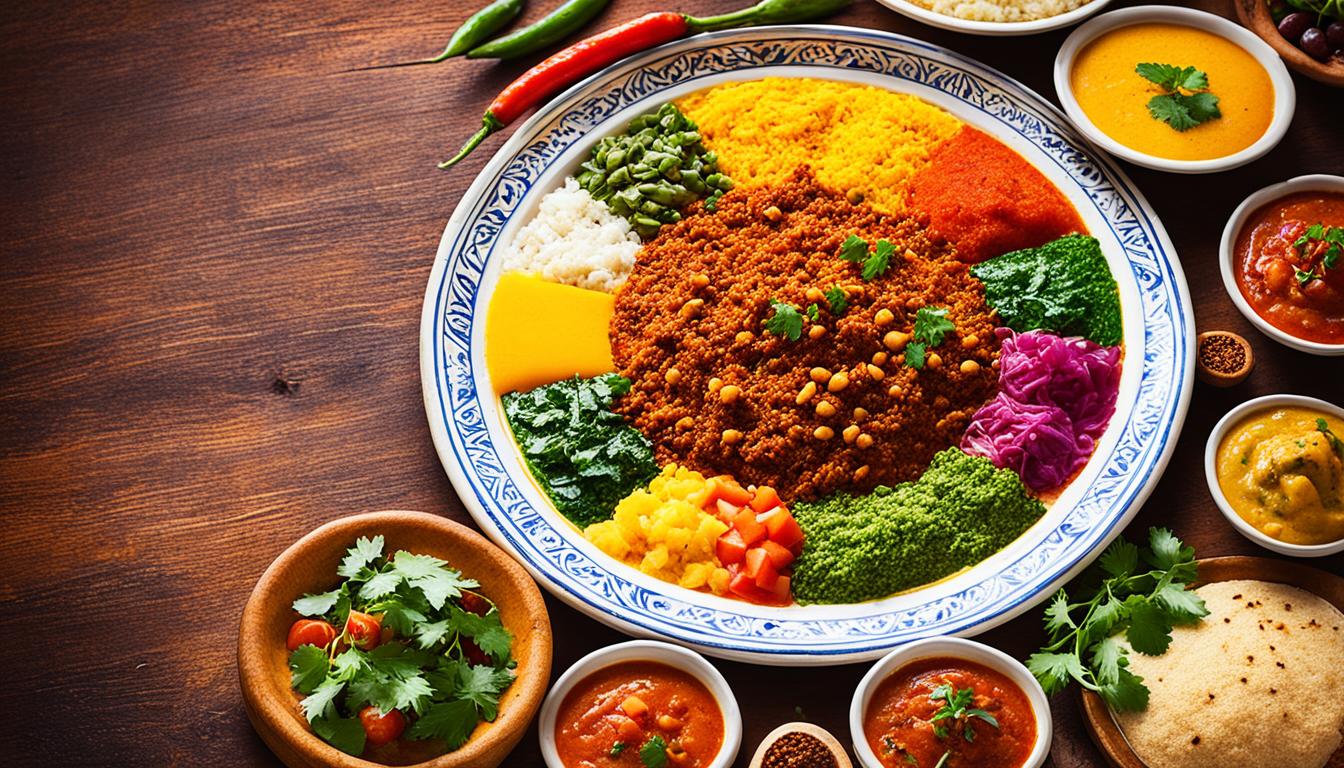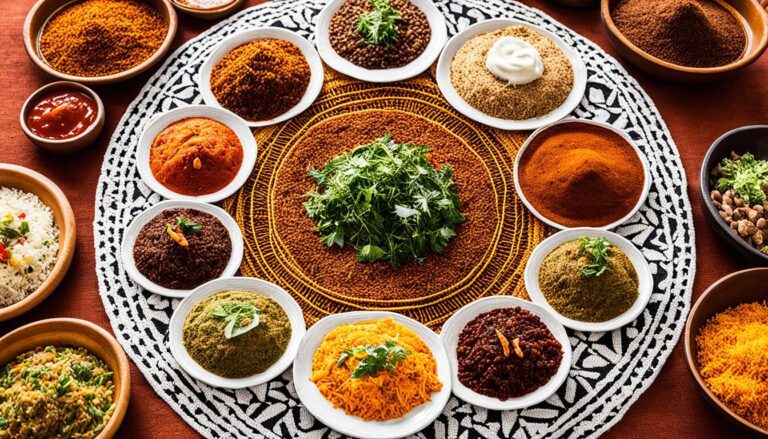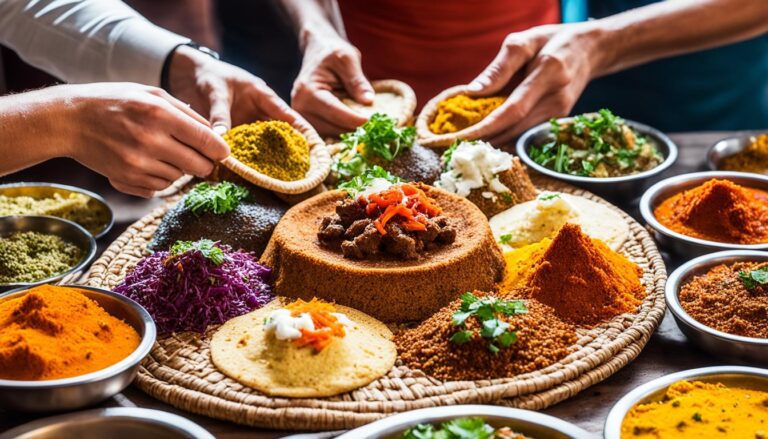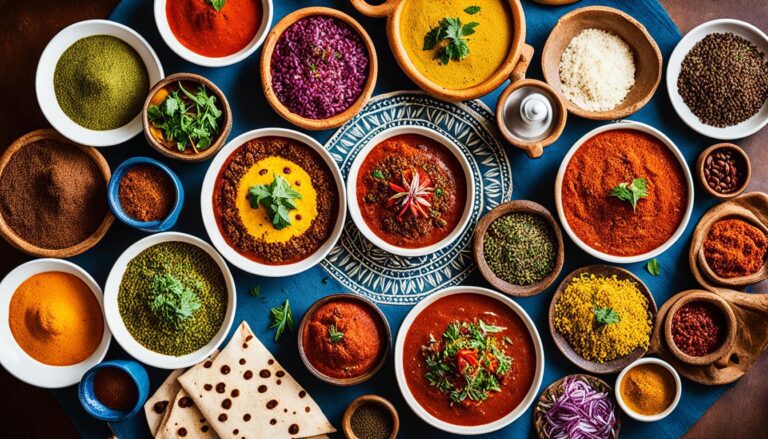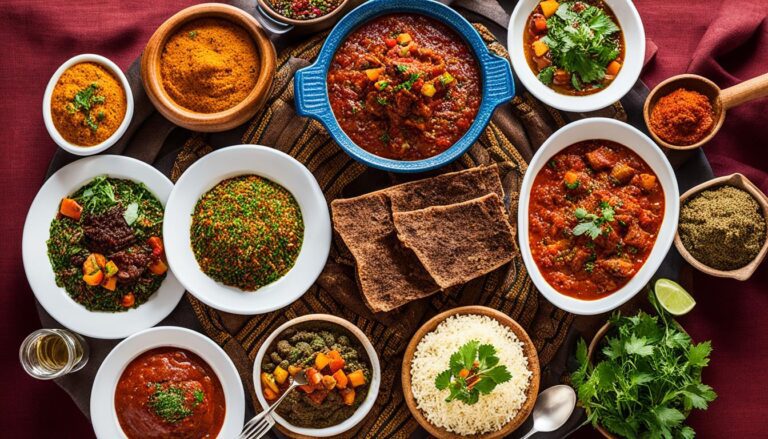Does Ethiopian Food Make You Gain Weight?
Are you a fan of Ethiopian cuisine but worried about the impact it may have on your waistline? Join us as we unravel the truth behind the question: Does Ethiopian food make you gain weight?
Ethiopian food is renowned for its bold flavors, unique textures, and rich cultural heritage. However, myths and misconceptions about its impact on weight gain abound. We’re here to provide you with the facts, dispel the common beliefs, and help you enjoy the flavors of Ethiopia without any guilt.
Key Takeaways:
- Busting the myth: Ethiopian food can be part of a healthy diet
- Understanding the nutritional qualities of Ethiopian ingredients
- Tips for balancing Ethiopian food in a healthy eating plan
- Exploring traditional cooking techniques and their impact on weight management
- The role of cultural practices and active lifestyles in Ethiopia
Introduction to Ethiopian Cuisine
Before we delve into the topic of Ethiopian cuisine and its potential impact on weight gain, let’s take a moment to familiarize ourselves with this rich and diverse culinary tradition. Ethiopian cuisine is known for its unique flavors, use of vibrant spices, and hearty dishes that reflect the country’s diverse cultural heritage.
One of the defining features of Ethiopian cuisine is the staple bread called injera. Made from fermented teff flour, injera is slightly sour and serves as the foundation of many Ethiopian meals. It is typically used as a utensil to scoop up various stews, curries, and vegetable dishes.
The flavors of Ethiopian cuisine are often a delightful blend of aromatic spices, such as berbere, a spice blend made from dried chilies, ginger, garlic, and various herbs and spices. This combination adds a unique and spicy kick to many Ethiopian dishes.
When it comes to Ethiopian cuisine, diversity is key. Vegetarian options abound, with lentils, chickpeas, and split peas featuring prominently in many dishes. Meat lovers can enjoy flavorful dishes like doro wat (spicy chicken stew) and kitfo (minced, seasoned beef).
Overall, Ethiopian cuisine offers a wide array of options for those seeking a flavorful culinary experience. In the following sections, we’ll explore the various ingredients used in Ethiopian food, strategies for balancing Ethiopian dishes in a healthy diet, the role of cooking techniques in weight management, and how the cultural practices and active lifestyles of Ethiopia further contribute to a holistic and enjoyable dining experience. Let’s dive in!
Typical Ingredients used in Ethiopian Food
Understanding the ingredients commonly used in Ethiopian dishes is key to determining their potential impact on weight gain. Ethiopian cuisine is known for its flavorful combinations and the use of various ingredients that contribute to its unique taste.
One staple ingredient in Ethiopian food is injera, a sourdough flatbread made from fermented teff flour. Teff is a highly nutritious grain rich in fiber, iron, and calcium. Injera serves as the foundation of many Ethiopian meals and is often accompanied by a range of delicious side dishes.
Lentils are another prominent ingredient in Ethiopian cuisine. They provide a good source of plant-based protein, dietary fiber, and essential minerals. Lentils are frequently used in flavorful stews, such as misir wot (spicy lentil stew).
The berbere spice blend is a vital component of Ethiopian cooking. It adds a characteristic heat and depth of flavor to many dishes. Berbere typically consists of chili peppers, garlic, ginger, fenugreek, and a blend of aromatic spices. This spice blend is responsible for the bold and complex flavors found in Ethiopian food.
Vegetables also play a significant role in Ethiopian cuisine. Popular choices include collard greens, carrots, cabbage, and potatoes. These vegetables are often seasoned with Ethiopian spices and incorporated into stews, stir-fries, and sautés.
Meat dishes are another integral part of Ethiopian cuisine. Traditional Ethiopian meals often include doro wat (spicy chicken stew), tibs (grilled meat), and kitfo (minced raw meat seasoned with spices).
The combination of these diverse ingredients creates a rich tapestry of flavors in Ethiopian food, making it a culinary experience worth exploring.

Balancing Ethiopian Food in a Healthy Diet
Maintaining a healthy weight is all about achieving a balance in our diets. When it comes to Ethiopian food, it’s no different. Here, we’ll explore strategies for incorporating Ethiopian cuisine into a balanced eating plan, ensuring you can enjoy the flavors while prioritizing your health.
Portion Control
One key aspect of maintaining a healthy diet is portion control. Ethiopian cuisine often features a variety of dishes served communally on a large platter, with injera – a type of sourdough flatbread – serving as the base. To manage portion sizes, try to be mindful of how much you consume. Opt for smaller portions of dishes high in calories or fat, and fill a significant portion of your plate with nutrient-rich vegetables and legumes.
Mindful Choices
Making mindful choices is another important factor in maintaining a healthy diet when enjoying Ethiopian food. Be conscious of the ingredients used in the dishes you select. Avoid or limit dishes that are fried or heavily seasoned with butter or oil, as they can contribute to excess calorie intake. Instead, focus on opting for grilled or steamed options, lean meats, and dishes with a variety of colorful vegetables.
Inclusion of Nutritious Sides and Accompaniments
Enhance the nutritional quality of your Ethiopian meals by including wholesome sides and accompaniments. Ethiopian cuisine offers a range of nutritious options, such as salads, lentil soups, and sautéed greens like collard greens or spinach. These side dishes not only provide essential vitamins and minerals but also help increase the overall volume of your meal without adding excessive calories.
The Role of Cooking Techniques in Weight Management
The cooking techniques employed in Ethiopian cuisine play a significant role in managing weight and promoting a healthy lifestyle. By understanding how traditional Ethiopian cooking methods can influence the caloric content of dishes, we can make informed choices to support our weight management goals.
Boiling, steaming, and stewing are commonly used cooking techniques in Ethiopian cuisine. These methods allow for the preservation of essential nutrients while minimizing the use of added fats or oils. Boiling, in particular, is a popular technique for preparing vegetables and legumes, ensuring that they retain their nutritional value without adding unnecessary calories.
Furthermore, steaming is a gentle cooking method that helps to lock in the flavors and natural moisture of the ingredients, resulting in vibrant and delicious dishes. It is often used for cooking injera, a staple flatbread in Ethiopian cuisine, which is made from fermented teff flour. Steamed injera is light and fluffy, making it a healthier alternative to oilier or fried bread options.
Stewing is another technique prevalent in Ethiopian cooking, especially for preparing meat-based dishes such as doro wat (spicy chicken stew) or siga wat (spicy beef stew). By slow-cooking the ingredients with a variety of aromatic spices, Ethiopian stews develop deep flavors without excessive fat content, providing a satisfying and nutritious meal.
The Impact on Weight Management
These cooking techniques ensure that Ethiopian food can be enjoyed as part of a balanced diet. By using minimal oils and fats and focusing on steaming, boiling, and stewing, Ethiopian cuisine offers flavorful options with reduced caloric content. Incorporating these techniques into our own cooking practices can support weight management efforts without compromising on taste or cultural authenticity.
Ultimately, by understanding and embracing the diverse cooking techniques of Ethiopian cuisine, we can continue to enjoy its vibrant flavors while promoting a healthy lifestyle that aligns with our weight management goals.

Cultural Practices and Active Lifestyles in Ethiopia
Cultural practices and traditions are integral components of our lives and have a significant impact on our overall well-being. In Ethiopia, vibrant cultural practices and an active lifestyle are deeply ingrained in the daily lives of its people, fostering a strong sense of community and promoting healthy habits.
The Ethiopian culture places great emphasis on communal meals, where family and friends come together to share not only food but also stories, laughter, and love. This cultural practice encourages a mindful and relaxed approach to eating, promoting a healthier relationship with food.
Traditional Ethiopian cuisines, such as injera (a sourdough flatbread) and a variety of delicious stews and vegetable dishes, are typically served on a communal platter called a mesob. This communal style of dining encourages moderation and the sharing of dishes, allowing for a balanced and varied meal.
Active lifestyles are also a key component of Ethiopian culture. Walking and physical activity are deeply ingrained in the Ethiopian way of life. Many Ethiopians rely on walking as their primary mode of transportation, leading to increased physical activity throughout the day. Additionally, traditional dances and sports, such as the famous Ethiopian long-distance running, are celebrated and widely practiced.
These cultural practices and the active lifestyle in Ethiopia contribute to a holistic approach to health and well-being. The combination of regular physical activity and mindful eating habits helps maintain a healthy weight and overall wellness.
The Power of Cultural Practices and Active Lifestyles
Embracing cultural practices and adopting an active lifestyle can lead to numerous benefits, including:
- Improved cardiovascular health
- Enhanced mental well-being
- Stress reduction
- Increased energy levels
- Stronger social connections
By incorporating the cultural practices and active lifestyles of Ethiopia into our own lives, we can embrace a healthier and more balanced way of living. We can enjoy the rich flavors of Ethiopian cuisine while reaping the physical, mental, and social benefits that come with it.
Conclusion
In conclusion, incorporating Ethiopian food into your diet can be done without the fear of weight gain. By making mindful choices and practicing portion control, you can enjoy the authentic flavors of Ethiopian cuisine while maintaining a healthy weight.
One of the key factors in balancing Ethiopian food in a healthy diet is portion control. Opting for smaller serving sizes of dishes like injera, lentils, and traditional stews can help manage calorie intake. Additionally, incorporating nutritious sides and accompaniments, such as vegetable dishes, salads, and lean proteins, can enhance the nutritional value of your meal without compromising taste.
It’s also essential to understand that cultural practices and active lifestyles play a significant role in weight management. Ethiopian culture embraces physical activity through practices like communal cooking, traditional dances, and outdoor activities. By embracing these cultural practices and incorporating them into our own routines, we can enjoy the flavors of Ethiopian cuisine while leading an active and balanced lifestyle.
In summary, Ethiopian food can be a delicious and healthy addition to your diet. By practicing portion control, making mindful choices, and embracing the active lifestyle associated with Ethiopian culture, you can experience the diverse and vibrant flavors of this cuisine while maintaining a healthy weight.

